The Toshiba MKx001GRZB enterprise SSD was announced a year ago and went into full production in early-2011 and is Toshiba’s flagship enterprise SSD; all of this seemingly done at a snail’s pace when compared to the rapid churn of client-based SSDs. But in the enterprise, SSD storage buying decisions take time and aren’t at all about the burst, or top line speed numbers – it’s all about how the drive performs cranking away 24/7 for the many years it’s expected to live in steady state. While the enterprise scales up SSD adoption, there’s quite a battle in the trenches amongst manufacturers who are trying to solve a variety of problems, not the least of which is around SSD form factor and NAND configuration. For its part, Toshiba is leveraging a 6Gb/s SAS interface and 2.5" form factor for the MKx001GRZB, along with 32nm enterprise-grade SLC NAND to meet the needs of their clients.
Toshiba brings a tremendous portfolio of experience to the table with the MKx001GRZB; they hold a unique market position with both deep exposure to the hard drive space and ownership of their own NAND fabs. They also architect their own firmware and are using Marvell’s 88SS9032-BLN2 enterprise grade SSD processor. This all combines together to create an SSD that is not only capable of market-leading performance, but has the depth of support required to ensure compatibility with host systems and superior drive endurance.
The MKx001GRZB family is available in 100GB, 200GB and 400GB capacities, our single drive review is of the 400GB model. Each capacity also supports 512, 520, and 528-byte sector sizes. This versatility allows Toshiba to position this SSD in a multitude of environments.
Compared to other enterprise SLC-based SSDs currently on the market, Toshiba really pushes their SSD as a drive that competes not only on great write endurance, but also one that can deliver high read performance. The MKx001GRZB product line advertises 4K random read speeds upwards of 90,000 IOPS, with steady state write speeds peaking at 16,000 IOPS. Toshiba also promotes their power efficiency, with the drive needing only 6.5 watts while active, giving it a 13,800 IOPS/Watt rating. We put each claim to the test in our newly redesigned enterprise SSD testing regimen.
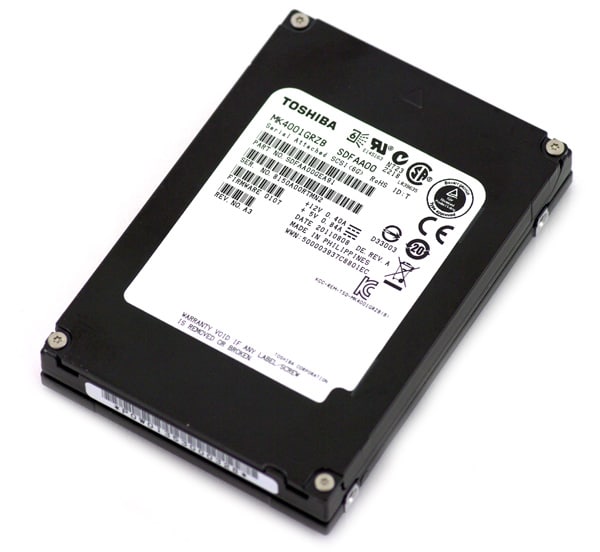
Toshiba MKx001GRZB Specs
- Capacities
- 100GB (MK1001GRZB,128GB Physical)
- 200GB (MK2001GRZB, 256GB Physical)
- 400GB (MK4001GRZB, 512GB Physical)
- Marvell-powered 6Gb/s SAS interface
- 32nm SLC Toshiba NAND
- Sector size – 512, 520, 528-byte
- Sequential read – 500 MB/s (QD4)
- Sequential write – 250 MB/s (QD4)
- 4KB Random Read 90,000 IOPS (QD16)
- 4KB Random Write 16,000 IOPS (QD16)
- Sustained 4KB Random combined (70%/30% Read/Write, 100% Duty) – 33,500 IOPS
- Active power consumption – 6.5 watts
- Total Storage Capacity of Data Written – Unlimited 200GB and 400GB (8.2PB on 100GB MK1001GRZB)
- Product life – 5 Years
- Dimensions – 69.85mm x 100mm x 15mm
- Weight – 152g
- Firmware Reviewed – 0107
Design and Disassembly
The 2.5-inch Toshiba MKx001GRZB SAS 6.0Gb/s SSD has a 15mm drive height, identical to current generation 10k and 15k 2.5-inch hard drives. This form factor is compatible across the board in many enterprise servers, especially those designed around the SAS interface.
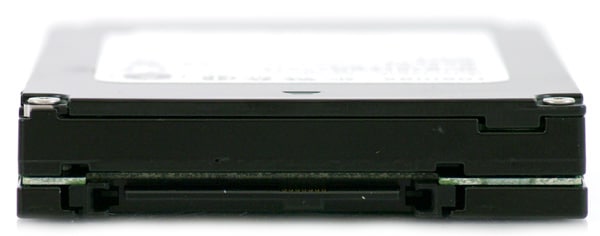
On the outside the drive keeps a rather professional look and feel, with a black machined-alloy body. Little branding is found on the drive itself save for the OEM label, which includes model name, serial number, firmware revision, and revision number.
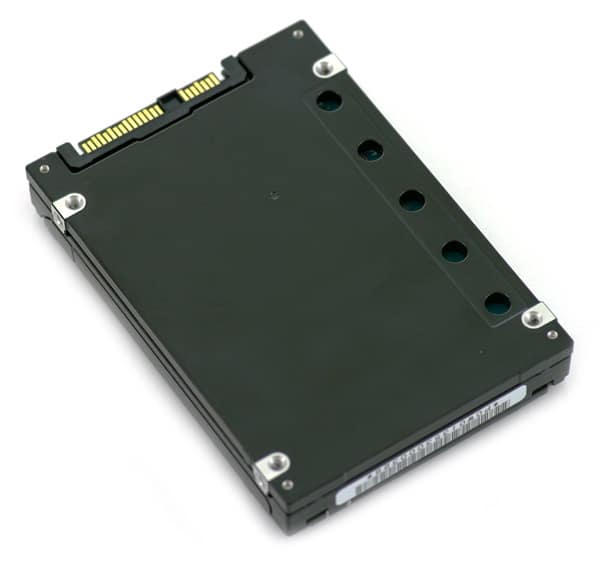
The drive itself is rather sturdy given the thick metal panels making up the top and bottom covers. Both covers screw together around a middle section that both circuit boards are screwed on to. This sandwich design puts thermal conductors on all primary components, including the NAND, onboard cache, controller, and capacitors all the while passing it off the drive and into the chassis of the server for cooling. Given the 24/7 access this drive is intended for, shedding heat before it affects reliability or performance is a big deal.
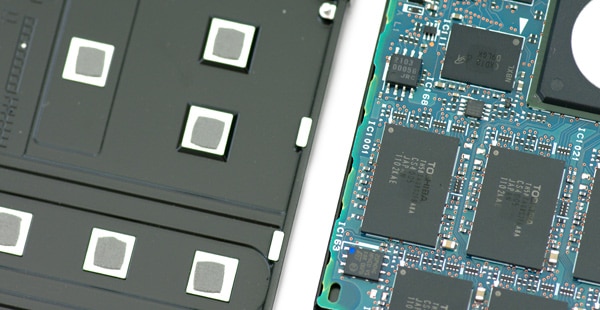
Internally the Toshiba MKx001GRZB is split up between two circuit boards attached to each other through a connector. On the 400GB MK4001GRZB this puts the controller, on-board cache, and six 32GB SLC NAND pieces on one board and ten 32GB SLC NAND pieces with four ultra-capacitors on the other.
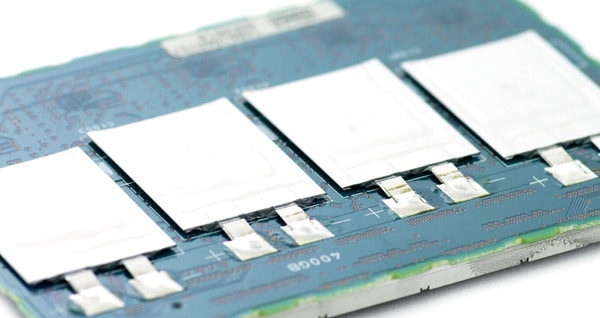
Each layer has thermal pads that take heat off the circuitry and move it into the thick metal frame of the drive. Even the bottom of the main board that has no primary components (NAND, RAM, etc) attached to it still has thermal pads to cool the underside of the circuit board from heat transmitted through from the components up above.
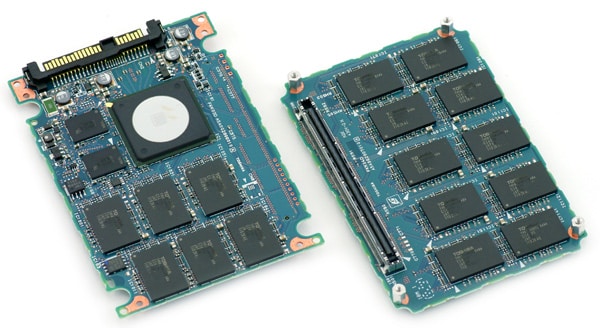
It’s only fitting that the Toshiba MKx001GRZB would utilize Toshiba SLC-NAND given their in-house NAND production capabilities.
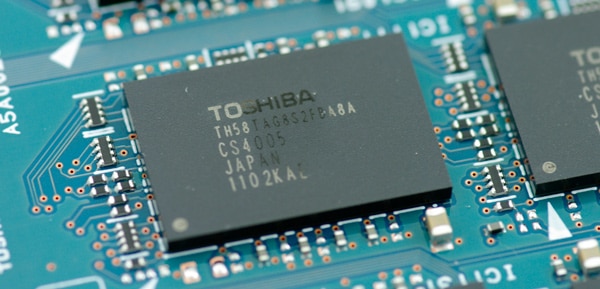
The MKx001GRZB internally has room for sixteen flash pieces divided between both circuit boards, which on the 400GB model uses 32GB Toshiba TH58TAG8S2FBA8A, giving it 512GB total before over-provisioning.
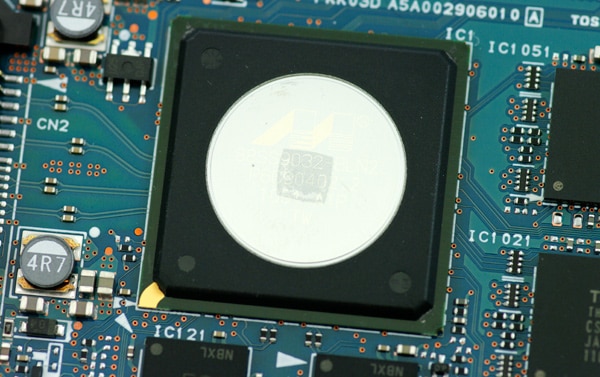
A Marvell 88SS9032-BLN2 SAS 6.0Gb/s controller ties the entire drive together, supporting transfer speeds up to 500MB/s read and 250MB/s write sequential and up to 90,000 IOPS random read. Buffering the data flow are two Micron D9LGK DDR3 ICs with a capacity of 256MB each (512MB total) and held up in the event of a power failure with the four large capacitors on the secondary circuit board.
Enterprise Benchmarks
One of the hot topics when flash media reviewing standards come up, is that flash media needs to be tested in a different manner than standard platter drives and even client-based SSDs. Flash performance changes the longer you write to a drive and speeds slowly taper down until the drive hits its steady state speed. In an enterprise setting, seeing a burst or sustained speed is worthless if after 1 hour of use the drive is no longer getting that speed. It is even less informative looking at burst figures if the drive in question will never go out of steady-state once it fills up. That is the case with the Toshiba MKx001GRZB, which to limit excessive write cycles only performs its garbage collection modes during write activity, not at idle. This is where steady state benchmarking comes in, showing how the drive really performs when it is under a 24/7 load. For this reason, all of the following benchmarks were pre-conditioned and recorded in a steady-state mode.
Given the different nature of this review, we re-benchmarked the 100GB Micron P300 (SATA, SLC NAND) to accurately compare it against the Toshiba MKx001GRZB in our new testing methodology. The new testing platform used in this review is our Lenovo ThinkServer RD240, equipped with dual Intel Xeon X5650 processors, running Windows Server 2008 R2. For our single-drive benchmarks we connected each SSD through a LSI SAS 9211-8i HBA to measure performance without any influence of caching. All IOMeter figures are represented as binary figures for MB/s speeds.
Our first test looks at the speed in a sequential write environment with large block transfers. This particular test uses a 2MB transfer size with IOMeter, with 4k sector alignment and measures performance with a queue depth of 4. In this scenario Toshiba claims a read speed of 500MB/s and a steady-state write speed of 250MB/s.
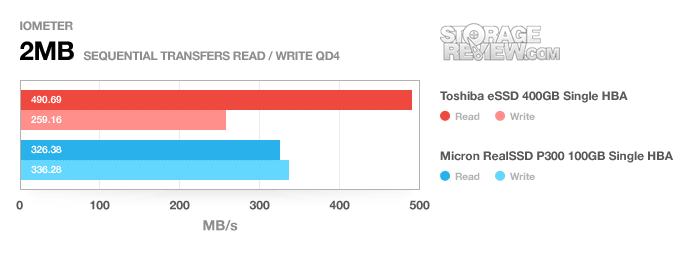
In our tests we measured a steady read speed of 490.69MB/s read and a steady write speed of 259.16MB/s on the Toshiba MK4001GRZB. This compares to 326.38MB/s read and 336.28MB/s write from the Micron P300.
Moving to a random access profile, but still maintaining a large block transfer size of 2MB, we start to see how performance varies in a mult-user environment. This test keeps the same queue depth level of 4 that we used in the prior sequential transfer benchmark.
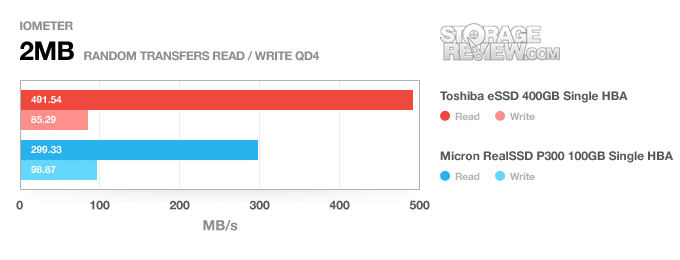
On the Toshiba MK4001GRZB we didn’t notice a huge shift in read speeds, actually picking up to 491.54MB/s. Write speeds on the other hand dropped to 85.29MB/s steady though. This compares to 299.33MB/s read and 98.87MB/s write from the Micron P300 once it hit steady-state.
Moving to an even smaller random access transfer size of 4K, we get closer to the packet size that might be found in a heavy random access environment such as a server setting with multiple VMs accessing the same array. In the first test we look at expanded 4K read performance and how it scales from a queue depth of 1 to a maximum of 64.
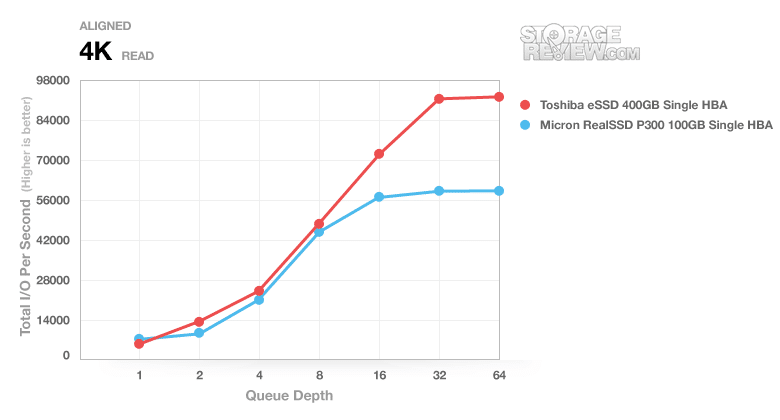
The Toshiba MK4001GRZB really stretched its legs in this particular test, showing off its ability to really make use of the SAS 6.0Gb/s interface. At a queue depth of 32 where performance started to plateau at 94,000 IOPS, peaking at 95,062 IOPS read at QD64. This translates out to 371.34MB/s write in pure 4K random access. The Micron P300 in the same setting peaked at 58.479 IOPS read at a QD32.
Our next test looks at 4K random write performance at a static queue depth of 32 and results are recorded and averaged once the drives have reached steady-state.
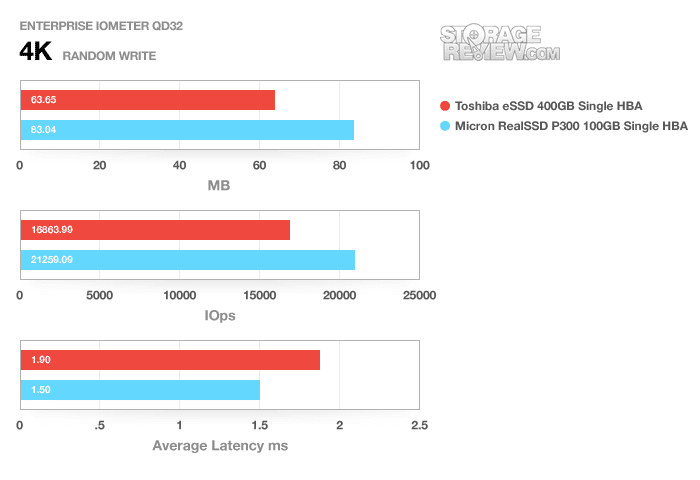
Toshiba’s official 4K random write speed is listed as 16,000 IOPS at a queue depth of 16, which we measured 16,863 IOPS at QD32. This compared to 21,269 IOPS from the Micron P300. During this steady-state access with 32 simultaneous requests both drives maintained very good average latency figures. The Toshiba MK4001GRZB averaged an access time of 1.9ms while the faster in 4K random write access Micron P300 scored 1.5ms.
While IOPS performance is a good metric to measure steady-state performance, another key area of interest is around average and peak latency. Higher peak latency figures can mean certain requests can backed up under heavy continuous access.
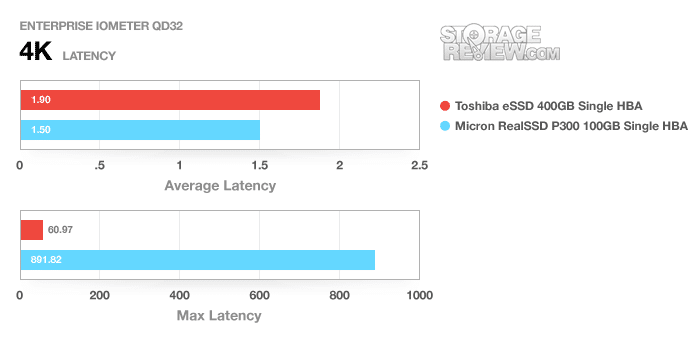
In the 4K steady state period, with constant access, the Micron P300 had a lower average latency figure but a higher peak latency time of 891.82ms. The Toshiba MK4001GRZB in the same environment had a slower average access time, but a much lower peak latency figure of 60.97ms.
Our last series of synthetic benchmarks compare both enterprise drives in a series of server mixed-workloads with a static queue depth of 32. Like the synthetic benchmarks at the start of this review, these tests are also measured in steady state. Each of our server profile tests has a strong preference towards read activity, ranging from 67% read with our database profile to 100% read in our web server profile.
The first is our database profile, with a 67% read and 33% write workload mix primarily centered on 8K transfer sizes.
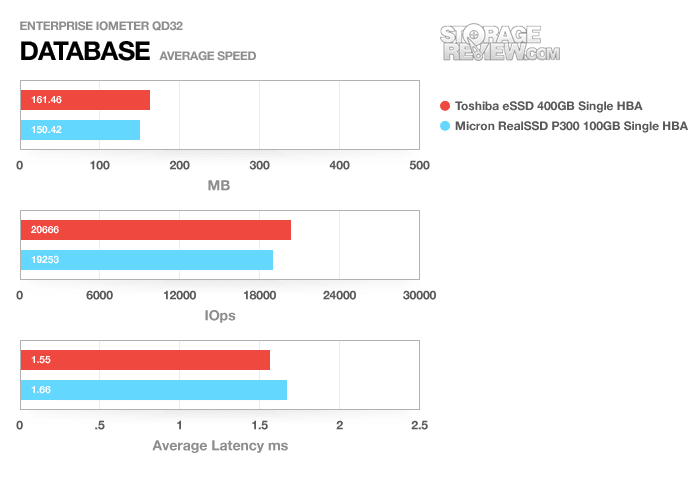
Both drives grouped closely together in steady-state, with the Toshiba MKx001GRZB edging out the Micron P300 by 7.3% or 11.04MB/s.
The next profile looks at a file server, with 80% read and 20% write workload spread out over multiple transfer sizes ranging from 512-byte to 64KB.
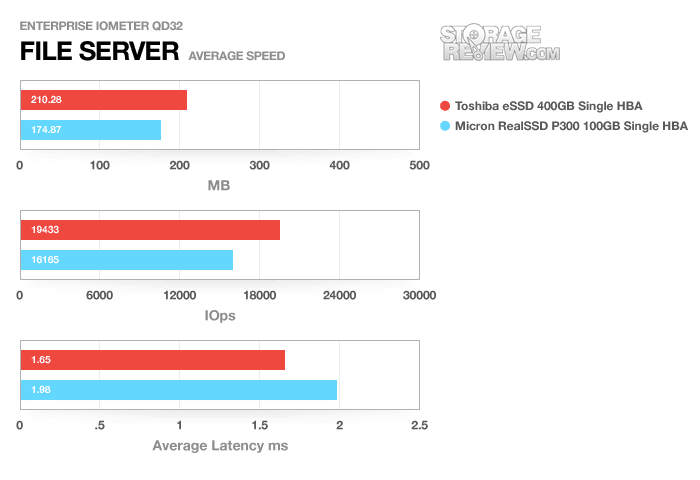
The gap between the two enterprise SSDs widened in the File Server profile, with the MKx001GRZB leading with an average transfer speed of 210.28MB/s or 19433 IOPS. This worked out to a lead of 35.41MB/s or 20.2%.
Our web server profile is read-only with a spread of transfer sizes from 512-byte to 512KB.
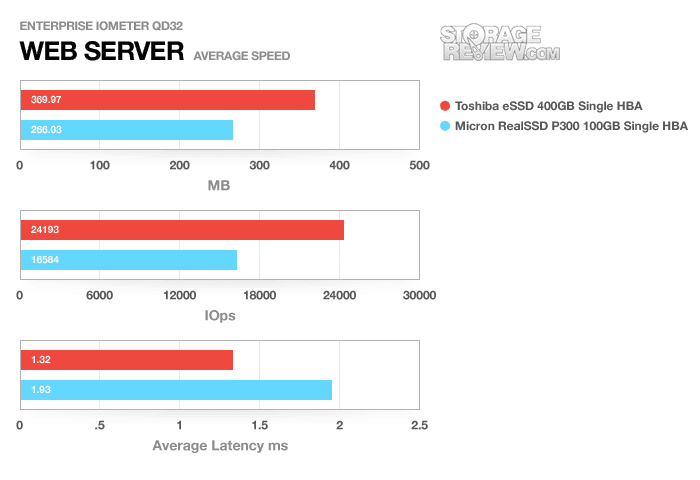
Given the huge boost in speed the Toshiba MKx001GRZB has over the Micron P300 in random read performance, it wasn’t a huge surprise to see it take off in the read-only web server environment. It averaged 369.97MB/s compared to just 266.03MB/s from the P300.
The last profile looks at a workstation, with a 20% write and 80% read mixture using 8K transfers.
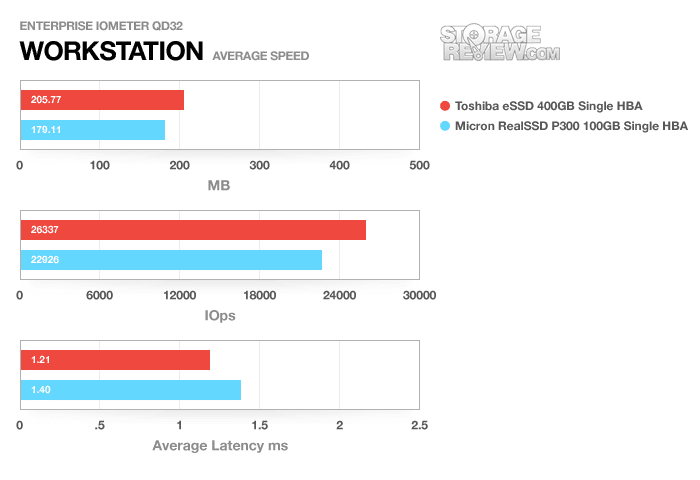
In the workstation setting, the gap narrowed compared to the previous profile, but the Toshiba MKx001GRZB still maintained the lead. It outpaced the Micron P300 by 26.66MB/s with an average total speed of 205.77MB/s.
Enterprise Power Consumption
When it comes to choosing drives for the datacenter or other densely-packed storage environment, performance isn’t the only metric companies are interested in when looking at SSDs or hard drives. Power consumption can be a huge deal in certain cases, so it makes sense that you would want to know how a drive would perform under a constant workload. In the Enterprise Power section of this review, we look at each drive under the same conditions we used to test the read and write speeds in earlier. This includes sequential and random 2MB transfers with a queue depth of 4 and small random 4K read and write transfers at a queue depth of 32. As with our previous tests we are measuring all figures in a steady-state to put the drive into its most power-hungry conditions.
Towards the latter-half of our power tests we look at a ratio of power to performance, working out an IOPS/Watt figure for both random 4K read and write figures, to see the full picture of each drive. For businesses looking to get the most bang for their power or space constrained buck, this is the metric for them.
Each drive we compared in this review has their own unique power requirements, including 5V only for the Micron P300 and 5V + 12V for the Toshiba MKx001GRZB . To give a good starting point on power, Toshiba rates the MKx001GRZB as using 6.5 watts under active conditions.
Under all conditions except start-up, the Toshiba MKx001GRZB used exactly 6.50 watts or under. The most power hungry activity for the MKx001GRZB actually turned out to be sequential QD4 2MB read, using 6.5 watts on the nose. Second was 2MB steady write activity, with random 4K QD32 read coming in third and 4K QD32 steady write coming in fourth. In almost all areas the Toshiba MKx001GRZB used nearly double the power of the Micron P300, even though in some of those areas it offered faster speeds. So a trade off is made in some areas depending on the level of performance you are looking for.
Toshiba rates the MKx001GRZB as providing 13,800 IOPS/Watt in some areas. We calculated a figure of 16,385 IOPS/Watt in pure random 4K read at a queue depth of 32, dropping to 3,081 IOPS/Watt if you instead look at steady 4K random write. This compared to 38,481 IOPS/Watt read or 10,119 IOPS/Watt write on the Micron P300, which had lower power needs. It really comes down to the needs of the business, finding the best blend of power to performance (or just straight performance) that factors in when buying the SSD or hard drive.
Conclusion
The Toshiba MKx001GRZB ranks up there with the crème de la crème of 2.5" SLC enterprise-class SSDs. This drive features a SAS 6Gb/s interface, SLC NAND, transfer speeds in excess of 500MB/s and 4K read performance topping 95,000 IOPS, all the while still being able to crank away at 16,800 4K write IOPS for up to 8.2PB of TBW and likely beyond. Needless to say, this drive means business and runs business behind the scenes in datacenters around the world.
When focusing on an SSD for the enterprise environment, there are different types of drives positioned at different levels depending on the access and performance that’s required. The Toshiba MKx001GRZB is aimed at Tier 0 or the first in line when data is churning away on a 24/7 basis from the moment the server is brought online. In this setting the SSD has no trouble keeping up in speed, regardless of 10 hours in, 10 days in or 10 months in. With its strong Marvell 88SS9032 SAS controller paired with 512GB of Toshiba SLC-NAND, the MKx001GRZB is able to crank away at its advertised speeds for five years or more.
Pros
- Excellent mixed-workload performance
- Strong random 4K read performance topping 95,062 IOPS
- Very low peak steady-state maximum response times
Cons
- Higher power consumption than SATA-based Micron P300
Bottom Line
The Toshiba MKx001GRZB shows its strength in Tier0/1 storage where both performance over time and reliability are critical. Toshiba has a key advantage in that their leadership position in the NAND flash arena gives them a strong foundation for the SSD from reliability, performance and endurance perspectives. Further, the SAS interface, 2.5" form factor and 100GB, 200GB and 400GB capacity points give Toshiba’s customers the type of SSD they want, with price point flexibility.


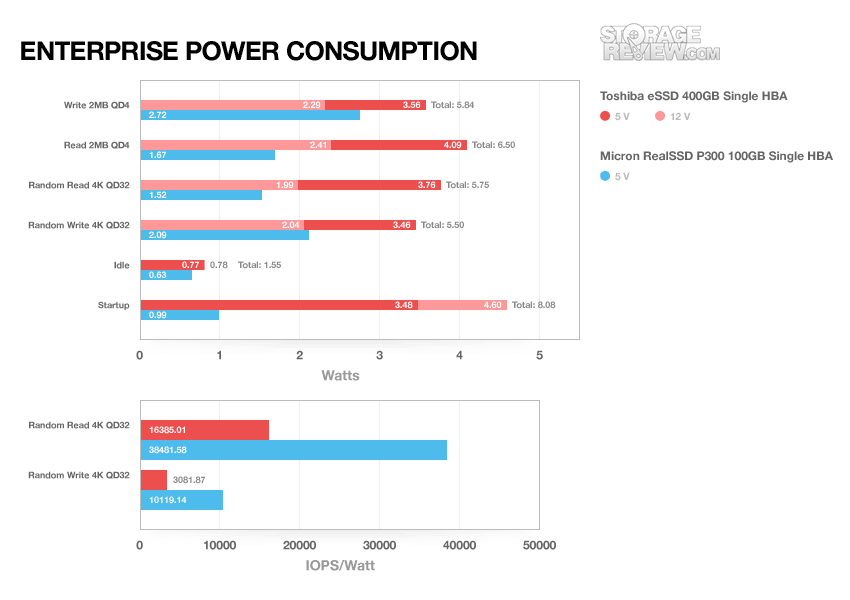


 Amazon
Amazon